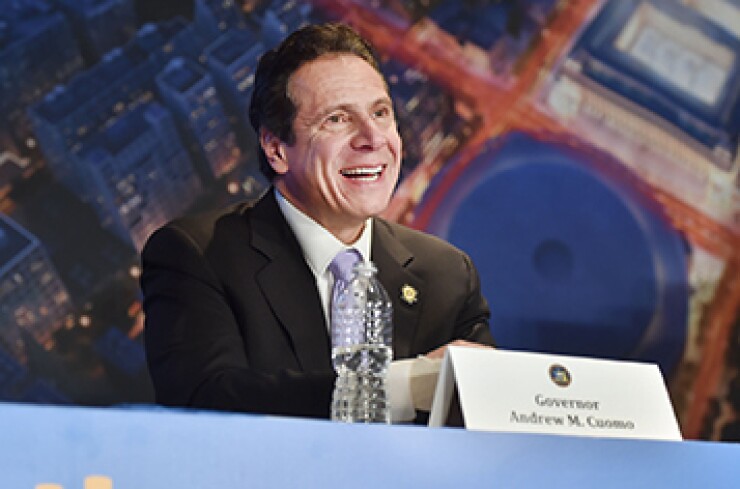
In a region notorious for delayed projects and balkanized governance, Gov. Andrew Cuomo is eager to fast-track his proposal – variables and all -- to rebuild New York's Pennsylvania Station.
Retail development is the engine.
"Cuomo clearly wants to do it. He probably sees the potential real estate benefits," said Nicole Gelinas, a senior fellow at the Manhattan Institute for Policy Research. "The main thing is how lucrative do the bidders think the retail space will be, with all the people going through."
Cuomo in January called for a $3 billion plan to renovate Penn Station under a public-private partnership, though the project looms as more of a real estate development play than a pure P3. Empire State Development Corp., Amtrak and the Metropolitan Transportation Authority are reviewing responses, the deadline for which passed last month.
Penn Station is one of several proposed megaprojects as the region attempts to fix its aging infrastructure. They include the proposed $20 billion Gateway train tunnel from New Jersey to New York, and calls to rebuild LaGuardia Airport in New York City's Queens borough and Port Authority Bus Terminal on Manhattan's West Side.
"In terms of importance, I'd rate Penn Station third behind the Gateway tunnels and the bus terminal," said Gelinas.
Nationally, the American Society of Civil Engineers is calling for $3.6 trillion in infrastructure investment by 2020 to cover a backlog.
"I do think we're at an interesting point in the country's history in terms of addressing the infrastructure problem," Chris Hamel, head of public finance at RBC Capital Markets, said on a Bond Buyer podcast. Hamel is promoting Infrastructure Week, a series of nationwide advocacy efforts.
Many loose ends remain to the Penn Station deal, according to a report by New York University's Rudin Center for Transportation Policy and Management.
"The joint solicitation implicitly raises a number of questions – about what types of improvements rail passengers can expect, and when; about how they will be financed; and about their ultimate effectiveness," said the report.
The station serves Amtrak, NJTransit, the MTA's Long Island Rail Road, and six New York City Transit subway lines.
Key project components include redeveloping the station and its Long Island Rail Road and New Jersey Transit concourses, and relocating the Amtrak waiting area and a restaurant-shop "train hall" across Eighth Avenue to the old Farley Post Office building while linking the complexes underground. Cuomo hopes to complete "substantial construction" of the two phases within three years.
A private entity would finance the project in exchange for retail development rights, according to Cuomo.
"A careful review of the problems that have long afflicted Penn Station, and the options available for alleviating them, suggests that the best approach is to complete the first and second phase of the Moynihan project as quickly as possible," said the Rudin report.
Meanwhile, the MTA, one of the largest municipal issuers with roughly $36 billion in debt, launched its own high-end retail corridor last month at its 59th Street-Columbus Circle station, which serves five subway lines and is the city's seventh-busiest complex.
"I thought MTA did a very good job with it," said Gelinas.
TurnStyle, a 30,000-foot undertaking, is a renovated 325-foot-long passageway leading from 57th Street and 8th Avenue to the train platforms. It features 39 retail and food vendors including 12 boutique shops, 20 gourmet eateries and a series of pop-up vendor kiosks.
"It is heavy traffic for the lucky businesses opening up shop and it is great for our customers because we can reinvest this corridor's rental revenues right back into our system," said Veronique "Ronnie" Hakim, president of the MTA's New York City Transit unit.
The $3 billion projection for the Penn Station project includes $2 billion to redevelop Farley and Penn and at least $1 billion for ancillary retail and commercial developments between 7th and 9th avenues. Cuomo said $325 million of this would come from government sources, including the U.S. Department of Transportation, Port Authority of New York and New Jersey and Amtrak.
Cost factor alone could silence populist calls to relocate Madison Square Garden, which sits above the station.
The Rudin report said moving the Garden could double the overall cost and force further delays through environmental challenges. Often mentioned as a new Garden site is the Morgan Annex, which the U.S. Postal Service owns and covers two full blocks between 9th and 10th avenues and 28th and 30th streets.
Variables, though, include a high land acquisition price plus possible pushback from residents and small business owners in the adjacent Hell's Kitchen neighborhood, which is home to many rent-controlled apartments.
Those dynamics are prompting the Port Authority to redevelop its main bus terminal on its current parcel a few blocks north.
Even if retail revenue falls short, Cuomo could justify the cost on New Yorkers' visceral disdain for the current station, home to last-minute track assignments, mad commuter scrambles, decrepit bathrooms and scores of homeless people.
"Penn Station and Port Authority continue to be the bane of the existence of hundreds of thousands of people every day," Juliette Michaelson, executive vice president at the transportation think tank Regional Plan Association, said earlier this month at the RPA's annual assembly in midtown Manhattan.





